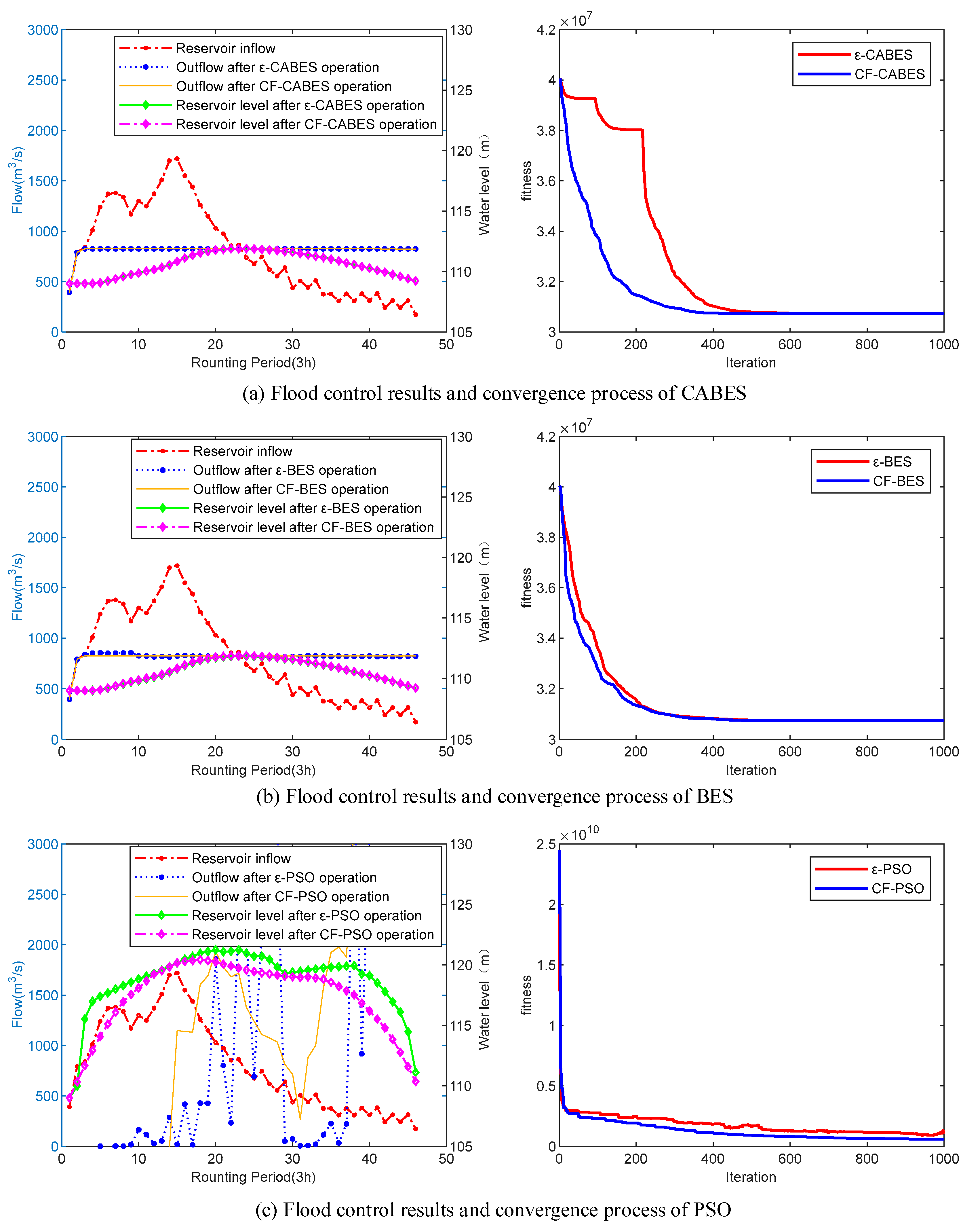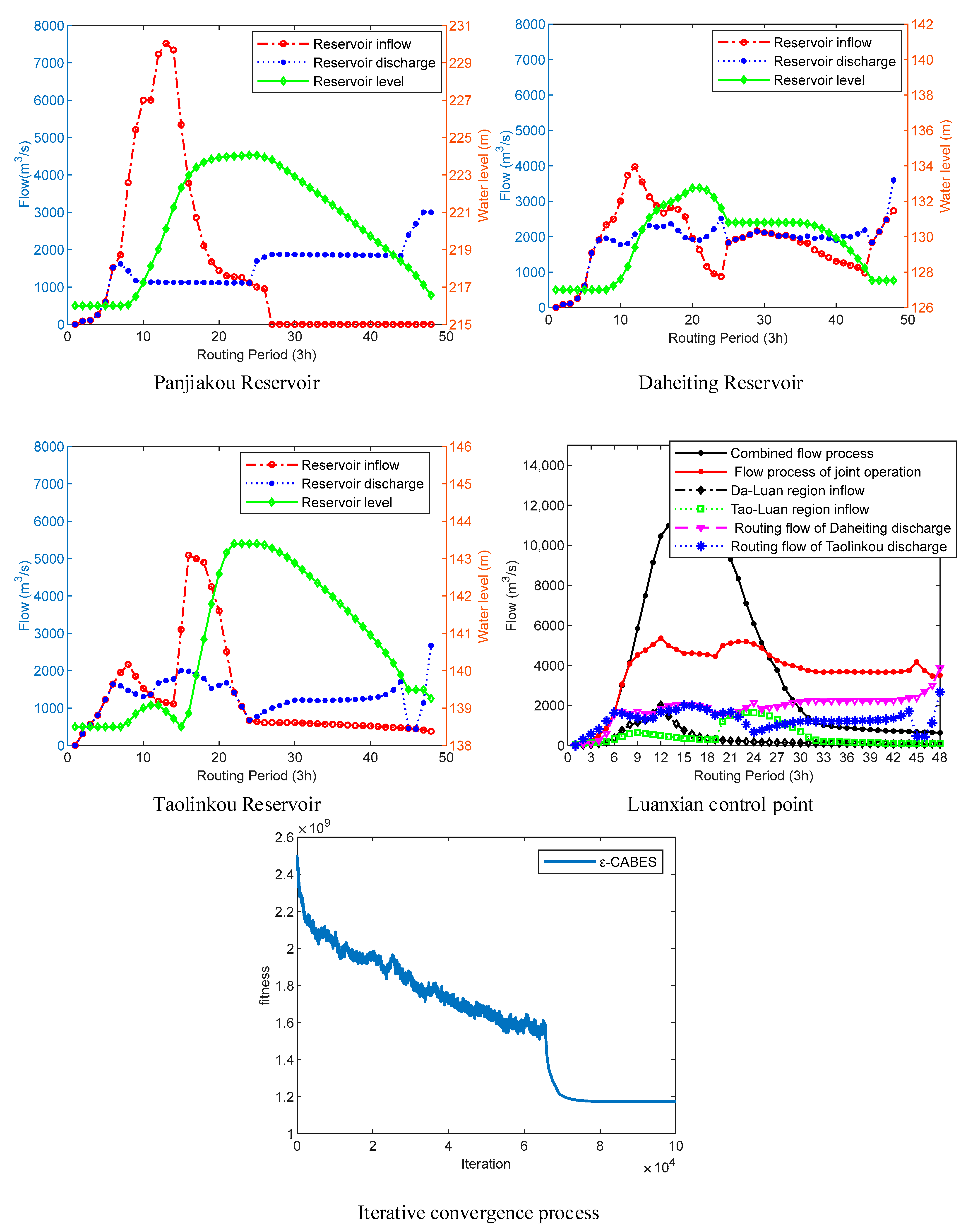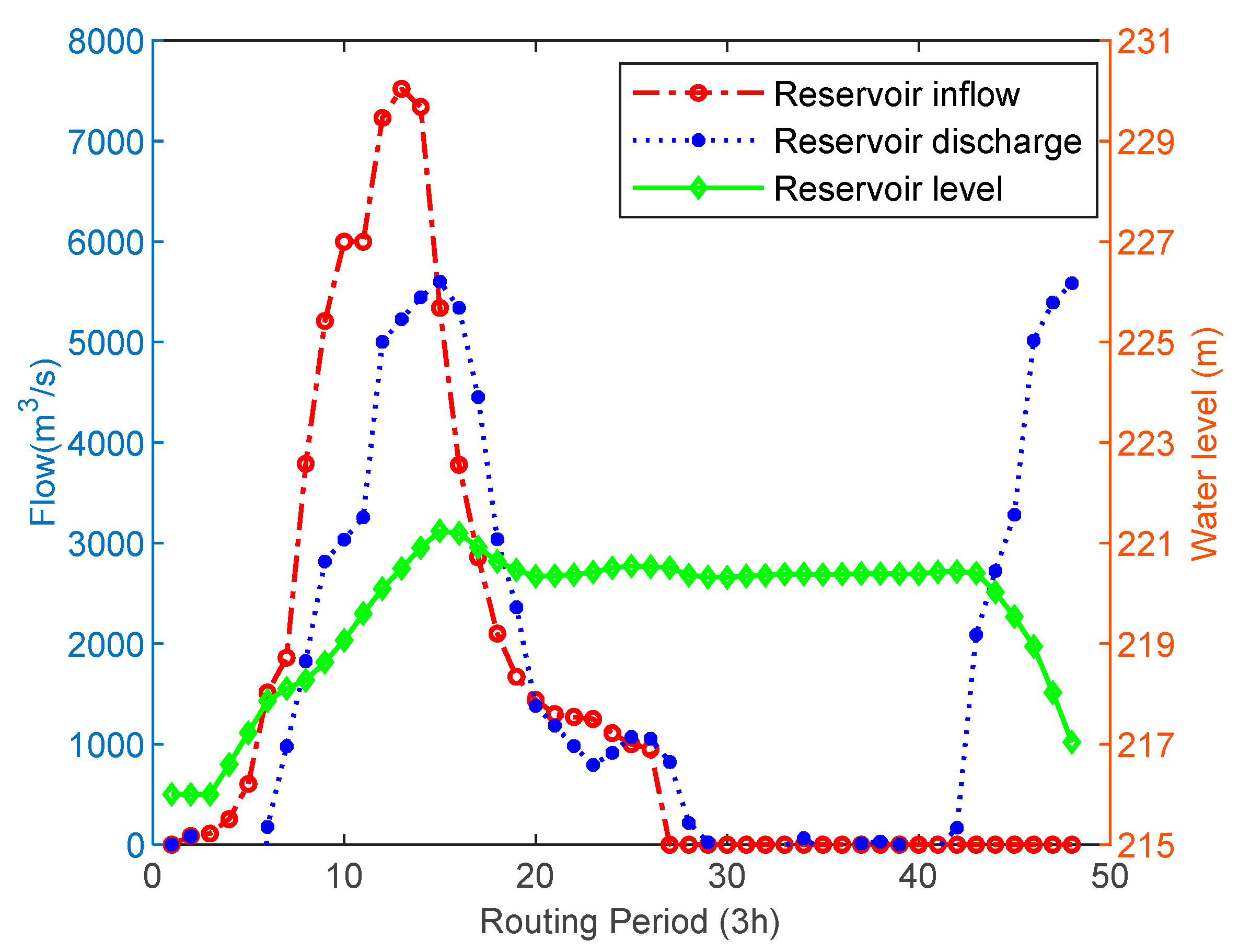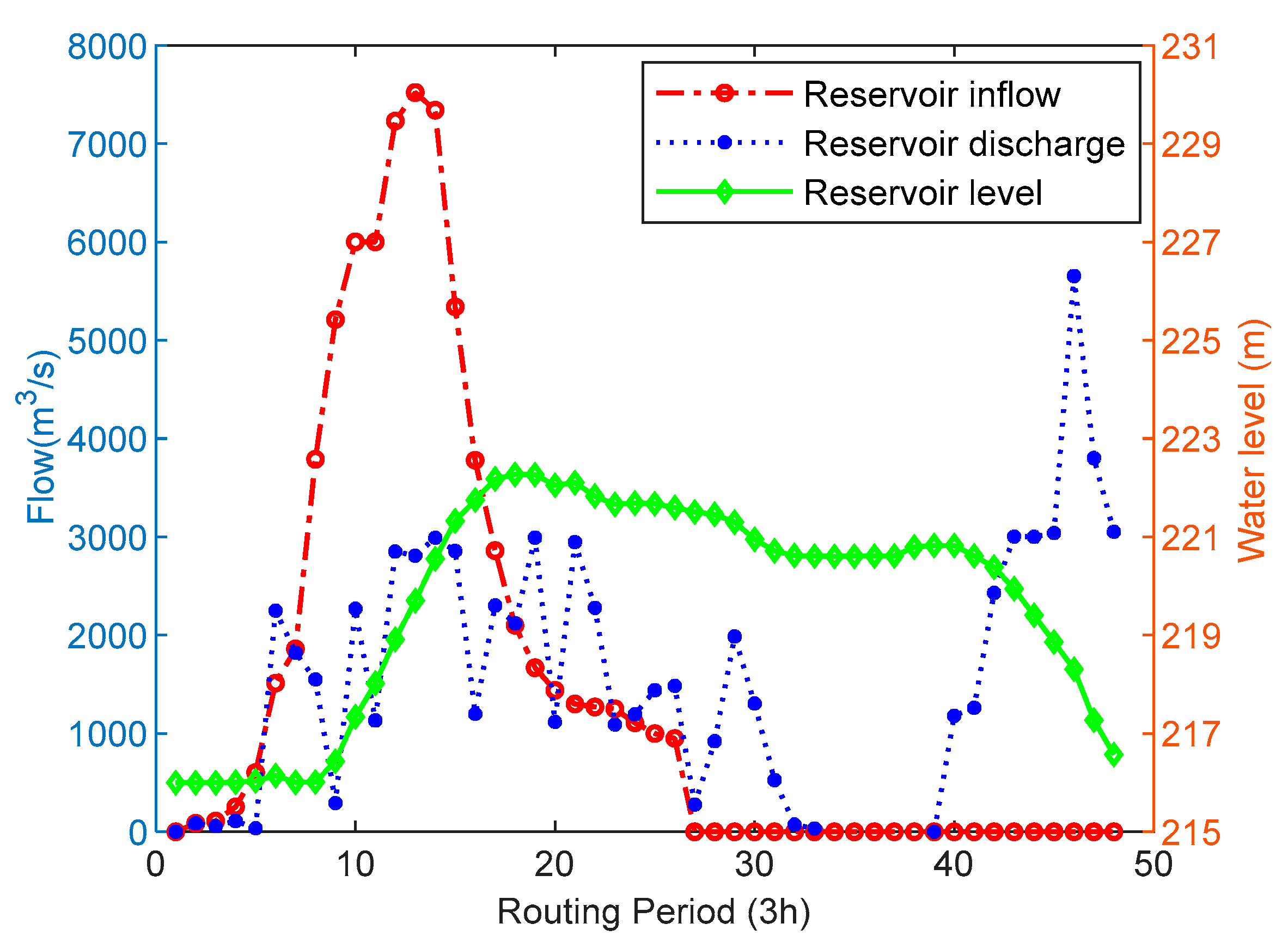Multi-Reservoir Flood Control Operation Using Improved Bald Eagle Search Algorithm with ε Constraint Method
Abstract
:1. Introduction
2. CABES Algorithm and Constraint Processing Technology
2.1. BES Algorithm
- (1)
- Selection stage
- (2)
- Search stage
- (3)
- Swoop stage
2.2. CABES Algorithm
2.2.1. Cauchy Mutation Strategy
2.2.2. Fusion of Adaptive Weights and Levy Flight Strategy
2.3. Experiment Design and Test Function
2.3.1. Algorithm Performance Analysis
2.3.2. Wilcoxon Sign Rank Sum Test
2.4. Constraint Processing Technology
2.4.1. ε. Constraint Method
2.4.2. Penalty Function Method
3. Flood Control Operation Model
3.1. Objective Function
3.2. Constraint Conditions
- (1)
- Constraint equation of reservoir water balance:
- (2)
- Upper and lower limits of water level constraints:
- (3)
- Discharge capacity constraints:
- (4)
- Restriction of water level at the end of the period:
- (5)
- Non-negative constraint: all the above variables are non-negative values.
4. Case Studies
4.1. Basic Information of Reservoirs
4.2. Flood Control Operation Process Based on CABES Algorithm
- Step 1.
- (Initialization): Population size N, total iterations Maxt, constraint violation ε, or penalty factor c are determined. According to the water level at the end of different periods of the reservoir, the number of N groups of particles at the end of the period is randomly generated as the initial population of each generation. According to the constraint conditions, the corresponding fitness value is computed.
- Step 2.
- (Selection stage): The selection operation is performed according to Equation (12). Through the new position solution generated by the Cauchy mutation, the relevant constraints are used to solve the objective function value, and then combined with Equation (17) to select the pros and cons of the solution.
- Step 3.
- (Search stage): A new position solution is generated according to Equation (14) or Equation (17). The objective function value is also computed according to the constraints, and the optimal solution is selected in combination with Equation (21).
- Step 4.
- (Swoop stage): The position solution generated by Equation (10) is compared with the previous solution through the search and selection stages by Equation (21).
- Step 5.
- If the current number of iterations reaches the maximum number of iterations, the iteration ends and the optimal result is obtained. Otherwise, continue to Steps 2–4 and continue to iterate.
4.3. Results and Discussion
4.4. Conclusions of the Case Study Results
- (1)
- The length of flood period of a reservoir (group) has different requirements for the performance of algorithm and constraint processing technology. For reservoirs with few time periods, this is a simple operation problem, which requires low computational power of algorithms. Therefore, different algorithms combined with different constraint processing techniques can achieve appropriate flood control operation effects. With the increase of the number of time periods, better algorithms are needed to find the optimal strategy. The combination of conventional algorithms and constraint processing technology is difficult to sustain.
- (2)
- Through the flood control operation results of the Dahuofang Reservoir and Luan River Basin multi-reservoir system with more time periods, it can be observed that, under the same constraint processing technology, the CABES optimization algorithm proposed in this paper can achieve better results than those of the BES optimization algorithm before improvement, while the classical PSO algorithm does not find a suitable operation scheme in both instances. This demonstrates that as the complexity of the solution problem increases, the CABES algorithm obtained by improving the Cauchy mutation strategy and fusing the adaptive weighting factor with the Levy flight strategy is somewhat advanced and practical, improving the ability of the original algorithm to solve complex problems.
- (3)
- When the same algorithm uses two constraint processing techniques, the results of the operation scheme obtained by the two constraint processing methods are consistent when solving the operation scheme of Shafan Reservoir and Dahuofang Reservoir. However, in the dispatching of a mixed multi-reservoir system, the dispatching results are quite different. Therefore, it can be considered that the ε constraint treatment technology and the penalty function method have the same effect on the optimization treatment technology of a single reservoir, but the optimization effect of the ε constraint treatment technology is better than that of the penalty function method on more complex constraint problems.
5. Conclusions
- (1)
- The CABES algorithm is used to solve the three instances, and the comparative analysis with the operation results of the BES and PSO algorithms shows that the CABES algorithm has better global search ability and better solution accuracy. Cauchy mutation and fusion of adaptive weight factor and Levy flight strategy can improve the performance of the algorithm in solving reservoir optimal operation.
- (2)
- The effect of the ε constraint processing technique is equivalent to that of the penalty function method in the relatively simple single-reservoir operation problem, and in the more complex multi-reservoir operation problem, the solution effect is ahead of the penalty function method. In general, the ε constraint processing technology has better convergence and achieves better optimization results.
- (3)
- For the dispatching problem of Shafan Reservoir with short time period, the dispatching schemes required by different algorithms are basically the same; for Dahuofang Reservoir with long time period, the dispatching schemes of each algorithm are different. It shows that the length of the number of periods in the reservoir operation will affect the stability and difference of the operation results of each algorithm.
- (4)
- The ε-CABES algorithm can better solve the strong constraints, multistage, and nonlinear combination problems in the optimal operation of reservoir flood control, and provides an effective method for the optimal operation of reservoir flood control.
Author Contributions
Funding
Data Availability Statement
Conflicts of Interest
References
- Blöschl, G.; Hall, J.; Viglione, A.; Perdigão, R.A.P.; Parajka, J.; Merz, B.; Lun, D.; Arheimer, B.; Aronica, G.T.; Bilibashi, A.; et al. Changing climate both increases and decreases European river floods. Nature 2019, 573, 108–111. [Google Scholar] [CrossRef] [PubMed]
- Iyakaremye, V.; Zeng, G.; Yang, X.; Zhang, G.; Ullah, I.; Gahigi, A.; Vuguziga, F.; Asfaw, T.G.; Ayugi, B. Increased high-temperature extremes and associated population exposure in Africa by the mid-21st century. Sci. Total Environ. 2021, 790, 148162. [Google Scholar] [CrossRef] [PubMed]
- Sein, Z.M.M.; Zhi, X.; Ullah, I.; Azam, K.; Ngoma, H.; Saleem, F.; Xing, Y.; Iyakaremye, V.; Syed, S.; Hina, S.; et al. Recent variability of sub-seasonal monsoon precipitation and its potential drivers in Myanmar using in-situ observation during 1981–2020. Int. J. Climatol. 2022, 42, 3341–3359. [Google Scholar] [CrossRef]
- Xing, Y.; Shao, D.; Liang, Q.; Chen, H.; Ma, X.; Ullah, I. Investigation of the drainage loss effects with a street view based drainage calculation method in hydrodynamic modelling of pluvial floods in urbanized area. J. Hydrol. 2022, 605, 127365. [Google Scholar] [CrossRef]
- Kundzewicz, Z.W.; Su, B.; Wang, Y.; Xia, J.; Huang, J.; Jiang, T. Flood risk and its reduction in China. Adv. Water Resour. 2019, 130, 37–45. [Google Scholar] [CrossRef]
- Rahimi, H.; Ardakani, M.K.; Ahmadian, M.; Tang, X. Multi-Reservoir Utilization Planning to Optimize Hydropower Energy and Flood Control Simultaneously. Environ. Process. 2020, 7, 41–52. [Google Scholar] [CrossRef]
- Zhu, F.; Zhong, P.-a.; Sun, Y.; Xu, B. Selection of criteria for multi-criteria decision making of reservoir flood control operation. J. Hydroinform. 2017, 19, 558–571. [Google Scholar] [CrossRef]
- Yakowitz, S. Dynamic programming applications in water resources. Water Resour. Res. 1982, 18, 673–696. [Google Scholar] [CrossRef]
- Barros Mario, T.L.; Tsai Frank, T.C.; Yang, S.-l.; Lopes Joao, E.G.; Yeh William, W.G. Optimization of Large-Scale Hydropower System Operations. J. Water Resour. Plan. Manag. 2003, 129, 178–188. [Google Scholar] [CrossRef]
- Unver, O.I.; Mays, L.W. Model for real-time optimal flood control operation of a reservoir system. Water Resour. Manag. 1990, 4, 21–46. [Google Scholar] [CrossRef]
- Bai, T.; Wu, L.; Chang, J.-x.; Huang, Q. Multi-Objective Optimal Operation Model of Cascade Reservoirs and Its Application on Water and Sediment Regulation. Water Resour. Manag. 2015, 29, 2751–2770. [Google Scholar] [CrossRef]
- Zhang, W.; Liu, P.; Chen, X.; Wang, L.; Ai, X.; Feng, M.; Liu, D.; Liu, Y. Optimal Operation of Multi-reservoir Systems Considering Time-lags of Flood Routing. Water Resour. Manag. 2016, 30, 523–540. [Google Scholar] [CrossRef]
- Li, J.; Zhong, P.A.; Yang, M.; Zhu, F.; Chen, J.; Xu, B.; Liu, W. Dynamic and Intelligent Modeling Methods for Joint Operation of a Flood Control System. J. Water Resour. Plan. Manag. 2019, 145, 04019044. [Google Scholar] [CrossRef]
- Chen, H.-t.; Wang, W.-c.; Chen, X.-n.; Qiu, L. Multi-objective reservoir operation using particle swarm optimization with adaptive random inertia weights. Water Sci. Eng. 2020, 13, 136–144. [Google Scholar] [CrossRef]
- SeethaRam, K.V. Three Level Rule Curve for Optimum Operation of a Multipurpose Reservoir using Genetic Algorithms. Water Resour. Manag. 2021, 35, 353–368. [Google Scholar] [CrossRef]
- Xu, Y.; Mei, Y. A modified water cycle algorithm for long-term multi-reservoir optimization. Appl. Soft Comput. 2018, 71, 317–332. [Google Scholar] [CrossRef]
- Chen, H.-t.; Wang, W.-c.; Chau, K.-w.; Xu, L.; He, J. Flood Control Operation of Reservoir Group Using Yin-Yang Firefly Algorithm. Water Resour. Manag. 2021, 35, 5325–5345. [Google Scholar] [CrossRef]
- Chang, L.-C. Guiding rational reservoir flood operation using penalty-type genetic algorithm. J. Hydrol. 2008, 354, 65–74. [Google Scholar] [CrossRef]
- He, Y.; Xu, Q.; Yang, S.; Liao, L. Reservoir flood control operation based on chaotic particle swarm optimization algorithm. Appl. Math. Model. 2014, 38, 4480–4492. [Google Scholar] [CrossRef]
- Kumar Jha, D.; Yorino, N.; Zoka, Y.; Sasaki, Y.; Hayashi, Y.; Iwata, K.; Oe, R. Incorporating Penalty Function to Reduce Spill in Stochastic Dynamic Programming Based Reservoir Operation of Hydropower Plants. IEEJ Trans. Electr. Electron. Eng. 2010, 5, 531–538. [Google Scholar] [CrossRef]
- Moeini, R.; Soltani-nezhad, M.; Daei, M. Constrained gravitational search algorithm for large scale reservoir operation optimization problem. Eng. Appl. Artif. Intell. 2017, 62, 222–233. [Google Scholar] [CrossRef]
- Ngoc, T.A.; Hiramatsu, K.; Harada, M. Optimizing the rule curves of multi-use reservoir operation using a genetic algorithm with a penalty strategy. Paddy Water Environ. 2014, 12, 125–137. [Google Scholar] [CrossRef]
- Wang, W.; Jia, B.; Simonovic, S.P.; Wu, S.; Fan, Z.; Ren, L. Comparison of Representative Heuristic Algorithms for Multi-Objective Reservoir Optimal Operation. Water Resour. Manag. 2021, 35, 2741–2762. [Google Scholar] [CrossRef]
- Takahama, T.; Sakai, S. Constrained Optimization by ε Constrained Differential Evolution with Dynamic ε-Level Control. In Advances in Differential Evolution, Chakraborty, U.K., Ed.; Springer: Berlin/Heidelberg, Germany, 2008; pp. 139–154. [Google Scholar] [CrossRef]
- Chen, C.; Yuan, Y.; Yuan, X. An Improved NSGA-III Algorithm for Reservoir Flood Control Operation. Water Resour. Manag. 2017, 31, 4469–4483. [Google Scholar] [CrossRef]
- Stanovov, V.; Akhmedova, S.; Semenkin, E. Combined fitness–violation epsilon constraint handling for differential evolution. Soft Comput. 2020, 24, 7063–7079. [Google Scholar] [CrossRef]
- Zhou, J.; Zou, J.; Zheng, J.; Yang, S.; Gong, D.; Pei, T. An infeasible solutions diversity maintenance epsilon constraint handling method for evolutionary constrained multiobjective optimization. Soft Comput. 2021, 25, 8051–8062. [Google Scholar] [CrossRef]
- Alsattar, H.A.; Zaidan, A.A.; Zaidan, B.B. Novel meta-heuristic bald eagle search optimisation algorithm. Artif. Intell. Rev. 2020, 53, 2237–2264. [Google Scholar] [CrossRef]
- Alsaidan, I.; Shaheen, M.A.M.; Hasanien, H.M.; Alaraj, M.; Alnafisah, A.S. A PEMFC model optimization using the enhanced bald eagle algorithm. Ain Shams Eng. J. 2022, 13, 101749. [Google Scholar] [CrossRef]
- Angayarkanni, S.A.; Sivakumar, R.; Ramana Rao, Y.V. RETRACTED ARTICLE: Hybrid Grey Wolf: Bald Eagle search optimized support vector regression for traffic flow forecasting. J. Ambient Intell. Humaniz. Comput. 2021, 12, 1293–1304. [Google Scholar] [CrossRef]
- Eid, A.; Kamel, S.; Zawbaa, H.M.; Dardeer, M. Improvement of active distribution systems with high penetration capacities of shunt reactive compensators and distributed generators using Bald Eagle Search. Ain Shams Eng. J. 2022, 13, 101792. [Google Scholar] [CrossRef]
- Ferahtia, S.; Rezk, H.; Abdelkareem, M.A.; Olabi, A.G. Optimal techno-economic energy management strategy for building’s microgrids based bald eagle search optimization algorithm. Appl. Energy 2022, 306, 118069. [Google Scholar] [CrossRef]
- Sayed, G.I.; Soliman, M.M.; Hassanien, A.E. A novel melanoma prediction model for imbalanced data using optimized SqueezeNet by bald eagle search optimization. Comput. Biol. Med. 2021, 136, 104712. [Google Scholar] [CrossRef]
- Wang, W.-c.; Xu, L.; Chau, K.-w.; Xu, D.-m. Yin-Yang firefly algorithm based on dimensionally Cauchy mutation. Expert Syst. Appl. 2020, 150, 113216. [Google Scholar] [CrossRef]
- Zhao, S.; Wang, P.; Heidari, A.A.; Zhao, X.; Ma, C.; Chen, H. An enhanced Cauchy mutation grasshopper optimization with trigonometric substitution: Engineering design and feature selection. Eng. Comput. 2021, 38, 4583–4616. [Google Scholar] [CrossRef]
- Miao, F.; Yao, L.; Zhao, X. Symbiotic organisms search algorithm using random walk and adaptive Cauchy mutation on the feature selection of sleep staging. Expert Syst. Appl. 2021, 176, 114887. [Google Scholar] [CrossRef]
- Zhao, X.; Fang, Y.; Liu, L.; Xu, M.; Li, Q. A covariance-based Moth–flame optimization algorithm with Cauchy mutation for solving numerical optimization problems. Appl. Soft Comput. 2022, 119, 108538. [Google Scholar] [CrossRef]
- Wu, Q. Hybrid forecasting model based on support vector machine and particle swarm optimization with adaptive and Cauchy mutation. Expert Syst. Appl. 2011, 38, 9070–9075. [Google Scholar] [CrossRef]
- Nickabadi, A.; Ebadzadeh, M.M.; Safabakhsh, R. A novel particle swarm optimization algorithm with adaptive inertia weight. Appl. Soft Comput. 2011, 11, 3658–3670. [Google Scholar] [CrossRef]
- Rauf, H.T.; Malik, S.; Shoaib, U.; Irfan, M.N.; Lali, M.I. Adaptive inertia weight Bat algorithm with Sugeno-Function fuzzy search. Appl. Soft Comput. 2020, 90, 106159. [Google Scholar] [CrossRef]
- Shukla, A.K.; Singh, P.; Vardhan, M. An adaptive inertia weight teaching-learning-based optimization algorithm and its applications. Appl. Math. Model. 2020, 77, 309–326. [Google Scholar] [CrossRef]
- Sun, Y.; Wang, X.; Chen, Y.; Liu, Z. A modified whale optimization algorithm for large-scale global optimization problems. Expert Syst. Appl. 2018, 114, 563–577. [Google Scholar] [CrossRef]
- Khalilpourazari, S.; Khalilpourazary, S. An efficient hybrid algorithm based on Water Cycle and Moth-Flame Optimization algorithms for solving numerical and constrained engineering optimization problems. Soft Comput. 2019, 23, 1699–1722. [Google Scholar] [CrossRef]
- Wang, W.-C.; Xu, L.; Chau, K.-W.; Liu, C.-J.; Ma, Q.; Xu, D.-M. Cε-LDE: A lightweight variant of differential evolution algorithm with combined ε constrained method and Lévy flight for constrained optimization problems. Expert Syst. Appl. 2023, 211, 118644. [Google Scholar] [CrossRef]
- Seyyedabbasi, A. WOASCALF: A new hybrid whale optimization algorithm based on sine cosine algorithm and levy flight to solve global optimization problems. Adv. Eng. Softw. 2022, 173, 103272. [Google Scholar] [CrossRef]
- He, Q.; Lin, J.; Xu, H. Hybrid Cauchy mutation and uniform distribution of grasshopper optimization algorithm. Control Decis. 2021, 36, 1558–1568. [Google Scholar] [CrossRef]
- Wu, G.; Mallipeddi, R.; Suganthan, P. Problem Definitions and Evaluation Criteria for the CEC 2017 Competition and Special Session on Constrained Single Objective Real-Parameter Optimization; Technical Report; National University of Defense Technology, Changsha, Hunan, PR China and Kyungpook National University, Daegu, South Korea and Nanyang Technological University: Singapore, 2016. [Google Scholar]
- Zheng, Y.; Meng, Z.; Shen, R. An M-Objective Penalty Function Algorithm Under Big Penalty Parameters. J. Syst. Sci. Complex. 2016, 29, 455–471. [Google Scholar] [CrossRef]
- Tessema, B.; Yen, G.G. An Adaptive Penalty Formulation for Constrained Evolutionary Optimization. IEEE Trans. Syst. Man Cybern. Part A Syst. Hum. 2009, 39, 565–578. [Google Scholar] [CrossRef]
- Diao, Y.; Ma, H.; Wang, H.; Wang, J.; Li, S.; Li, X.; Pan, J.; Qiu, Q. Optimal Flood-Control Operation of Cascade Reservoirs Using an Improved Particle Swarm Optimization Algorithm. Water 2022, 14, 1239. [Google Scholar] [CrossRef]
- Ferahtia, S.; Rezk, H.; Djerioui, A.; Houari, A.; Motahhir, S.; Zeghlache, S. Modified bald eagle search algorithm for lithium-ion battery model parameters extraction. ISA Trans. 2022, in press. [Google Scholar] [CrossRef]
- Ma, L.; Zhang, T.; Li, Q.; Wang, T. Spatial distribution, risk assessment, and source identification of the potentially toxic elements in the water-level fluctuation zone of the Dahuofang Reservoir, Northeast China. Environ. Monit. Assess. 2021, 193, 454. [Google Scholar] [CrossRef]










| Function | Type | Optimal Value |
|---|---|---|
| F3 | Multimodal Functions | 300 |
| F6 | 600 | |
| F8 | 800 | |
| F21 | Composition Functions | 2100 |
| F23 | 2300 | |
| F24 | 2400 |
| Function | Algorithm | Best | Mean | Standard Deviation |
|---|---|---|---|---|
| F3 | BES | 1923.52 | 8122.14 | 4478.09 |
| CABES | 300.97 | 407.68 | 114.32 | |
| PSO | 107,727.00 | 208,286.00 | 50,031.60 | |
| F6 | BES | 633.39 | 645.92 | 8.27 |
| CABES | 600.00 | 600.26 | 0.49 | |
| PSO | 641.00 | 656.00 | 9.30 | |
| F8 | BES | 995.01 | 1078.79 | 45.07 |
| CABES | 937.30 | 1021.51 | 53.32 | |
| PSO | 1011.17 | 1151.26 | 51.50 | |
| F21 | BES | 2451.43 | 2520.37 | 35.48 |
| CABES | 2402.34 | 2465.49 | 31.28 | |
| PSO | 2556.89 | 2675.77 | 54.98 | |
| F23 | BES | 2926.15 | 3041.84 | 68.74 |
| CABES | 2844.83 | 2913.47 | 37.91 | |
| PSO | 3087.86 | 3297.07 | 116.25 | |
| F24 | BES | 3101.64 | 3235.85 | 100.43 |
| CABES | 3011.04 | 3085.16 | 45.82 | |
| PSO | 3293.15 | 3478.19 | 124.40 |
| Algorithm | CABES vs. BES | CABES vs. PSO |
|---|---|---|
| Function | p-value win | p-value win |
| F3 | 0.00 (+) | 0.00 (+) |
| F6 | 0.00 (+) | 0.00 (+) |
| F8 | 0.00 (+) | 0.00 (+) |
| F21 | 0.00 (+) | 0.00 (+) |
| F23 | 0.00 (+) | 0.00 (+) |
| F24 | 0.00 (+) | 0.00 (+) |
| (+/−/=) | 6/0/0 | 6/0/0 |
| Algorithm | ε-CABES | ε-BES | ε-PSO | CF-CABES | CF-BES | CF-PSO | |
|---|---|---|---|---|---|---|---|
| Parameters | ε | 10,000 | 10,000 | 10,000 | |||
| c (penalty factor) | 106 | 106 | 106 | ||||
| N (Shafan) | 50 | 50 | 50 | 50 | 50 | 50 | |
| Maxt (Shafan) | 500 | 500 | 500 | 500 | 500 | 500 | |
| N (Dahuofang) | 150 | 150 | 150 | 150 | 150 | 150 | |
| Maxt (Dahuofang) | 1000 | 1000 | 1000 | 1000 | 1000 | 1000 | |
| N (Luan River) | 200 | 200 | 200 | 200 | 200 | 200 | |
| Maxt (Luan River) | 100,000 | 100,000 | 100,000 | 100,000 | 100,000 | 100,000 | |
| w | 0.8 | 0.8 | |||||
| c1 | 0.5 | 0.5 | |||||
| c2 | 0.5 | 0.5 |
| Characteristic Parameters | Panjiakou | Daheiting | Taolinkou |
|---|---|---|---|
| Checking flood level (m) | 227.00 | 133.70 | 144.32 |
| Design flood level (m) | 224.50 | 133.00 | 143.40 |
| Total storage capacity (108 m3) | 29.30 | 4.73 | 8.59 |
| Benefit storage capacity (108 m3) | 19.50 | 2.07 | 7.09 |
| Dead water level (m) | 180.00 | 122.00 | 104.00 |
| Normal water level (m) | 222.00 | 133.00 | 143.00 |
| Flood limit water level (m) | 216.00 | 133.00 | 143.00 |
| Algorithm | ε-CABES | ε-BES | ε-PSO | CF-CABES | CF-BES | CF-PSO |
|---|---|---|---|---|---|---|
| 784,080.00 | 784,080.00 | 784,080.00 | 784,080.00 | 784,080.00 | 784,080.00 | |
| 784,080.00 | 784,080.00 | 784,080.00 | 784,080.00 | 784,080.00 | 784,080.00 | |
| 784,080.00 | 784,080.00 | 784,080.00 | 784,080.00 | 784,080.00 | 784,080.00 | |
| 784,080.00 | 784,080.00 | 784,080.00 | 784,080.00 | 784,080.00 | 784,080.00 | |
| 784,080.00 | 784,080.00 | 784,080.00 | 784,080.00 | 784,080.00 | 784,080.00 | |
| 784,080.00 | 784,080.00 | 784,080.00 | 784,080.00 | 784,080.00 | 784,080.00 | |
| 784,080.00 | 784,080.00 | 784,080.00 | 784,080.00 | 784,080.00 | 784,080.00 | |
| 784,080.00 | 784,080.00 | 784,080.00 | 784,080.00 | 784,080.00 | 784,080.00 | |
| 784,080.00 | 784,080.00 | 784,080.00 | 784,080.00 | 784,080.00 | 784,080.00 | |
| 784,080.00 | 784,080.00 | 784,080.00 | 784,080.00 | 784,080.00 | 784,080.00 | |
| Minimum | 784,080.00 | 784,080.00 | 784,080.00 | 784,080.00 | 784,080.00 | 784,080.00 |
| Mean | 784,080.00 | 784,080.00 | 784,080.00 | 784,080.00 | 784,080.00 | 784,080.00 |
| Median | 784,080.00 | 784,080.00 | 784,080.00 | 784,080.00 | 784,080.00 | 784,080.00 |
| Maximum | 784,080.00 | 784,080.00 | 784,080.00 | 784,080.00 | 784,080.00 | 784,080.00 |
| Standard deviation | 0.00 | 0.00 | 0.00 | 0.00 | 0.00 | 0.00 |
| Iteration duration (s) | 3.74 | 2.99 | 1.49 | 2.96 | 2.25 | 1.29 |
| Peak clipping rate (%) | 60.28 | 60.28 | 60.28 | 60.28 | 60.28 | 60.28 |
| Algorithm | ε-CABES | ε-BES | CF-CABES | CF-BES |
|---|---|---|---|---|
| 30,737,530.83 | 30,737,888.76 | 30,737,530.88 | 30,737,817.37 | |
| 30,737,532.02 | 30,737,871.90 | 30,737,532.03 | 30,737,731.38 | |
| 30,737,531.31 | 30,737,852.62 | 30,737,530.82 | 30,737,731.27 | |
| 30,737,532.18 | 30,737,577.04 | 30,737,530.95 | 30,737,782.44 | |
| 30,737,531.09 | 30,738,027.34 | 30,737,537.61 | 30,774,732.07 | |
| 30,737,530.96 | 30,737,649.03 | 30,737,530.90 | 30,737,576.15 | |
| 30,737,530.85 | 30,738,846.39 | 30,737,531.89 | 30,737,736.26 | |
| 30,737,533.62 | 30,738,133.48 | 30,737,531.25 | 30,737,633.93 | |
| 30,737,530.95 | 30,737,944.77 | 30,737,530.82 | 30,737,844.28 | |
| 30,737,531.10 | 30,737,641.22 | 30,737,531.16 | 30,737,681.17 | |
| Minimum | 30,737,530.83 | 30,737,577.04 | 30,737,530.82 | 30,737,576.15 |
| Mean | 30,737,531.49 | 30,737,943.25 | 30,737,531.83 | 30,741,426.63 |
| Median | 30,737,531.09 | 30,737,880.33 | 30,737,531.06 | 30,737,733.82 |
| Maximum | 30,737,533.62 | 30,738,846.39 | 30,737,537.61 | 30,774,732.07 |
| Standard deviation | 0.89 | 363.18 | 2.08 | 11,702.62 |
| Iteration duration (s) | 34.18 | 26.51 | 31.43 | 20.44 |
| Peak clipping rate (%) | 52.03 | 51.91 | 52.03 | 51.91 |
| Algorithm | ε-CABES |
|---|---|
| 1,176,703,090.13 | |
| 1,177,927,824.01 | |
| 1,176,640,533.05 | |
| 1,175,832,077.13 | |
| 1,177,365,505.25 | |
| 1,177,167,086.15 | |
| 1,177,890,549.69 | |
| 1,176,890,264.34 | |
| 1,177,026,241.21 | |
| 1,182,787,126.17 | |
| Minimum | 1,175,832,077.13 |
| Mean | 1,177,623,029.71 |
| Median | 1,177,096,663.68 |
| Maximum | 1,182,787,126.17 |
| Standard deviation | 1,175,832,077.13 |
| Iteration duration (s) | 4849.48 |
| Peak clipping rate (%) | 51.76 |
Disclaimer/Publisher’s Note: The statements, opinions and data contained in all publications are solely those of the individual author(s) and contributor(s) and not of MDPI and/or the editor(s). MDPI and/or the editor(s) disclaim responsibility for any injury to people or property resulting from any ideas, methods, instructions or products referred to in the content. |
© 2023 by the authors. Licensee MDPI, Basel, Switzerland. This article is an open access article distributed under the terms and conditions of the Creative Commons Attribution (CC BY) license (https://creativecommons.org/licenses/by/4.0/).
Share and Cite
Wang, W.; Tian, W.; Chau, K.; Zang, H.; Ma, M.; Feng, Z.; Xu, D. Multi-Reservoir Flood Control Operation Using Improved Bald Eagle Search Algorithm with ε Constraint Method. Water 2023, 15, 692. https://doi.org/10.3390/w15040692
Wang W, Tian W, Chau K, Zang H, Ma M, Feng Z, Xu D. Multi-Reservoir Flood Control Operation Using Improved Bald Eagle Search Algorithm with ε Constraint Method. Water. 2023; 15(4):692. https://doi.org/10.3390/w15040692
Chicago/Turabian StyleWang, Wenchuan, Weican Tian, Kwokwing Chau, Hongfei Zang, Mingwei Ma, Zhongkai Feng, and Dongmei Xu. 2023. "Multi-Reservoir Flood Control Operation Using Improved Bald Eagle Search Algorithm with ε Constraint Method" Water 15, no. 4: 692. https://doi.org/10.3390/w15040692
APA StyleWang, W., Tian, W., Chau, K., Zang, H., Ma, M., Feng, Z., & Xu, D. (2023). Multi-Reservoir Flood Control Operation Using Improved Bald Eagle Search Algorithm with ε Constraint Method. Water, 15(4), 692. https://doi.org/10.3390/w15040692










